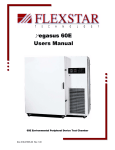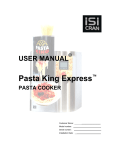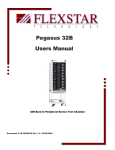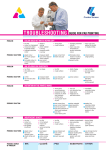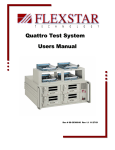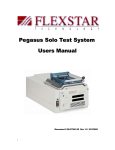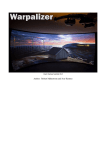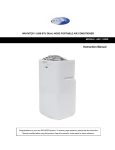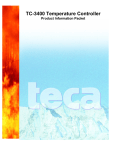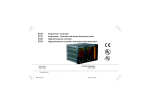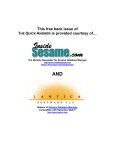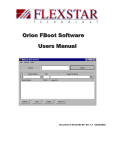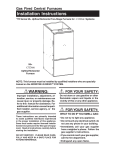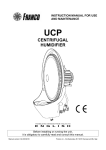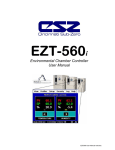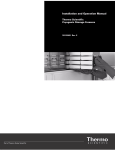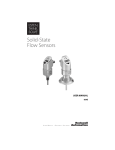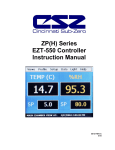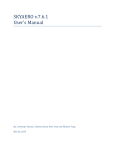Download 60E Users Manual - Flexstar Technology
Transcript
60E Users Manual 60E Environmental Peripheral Device Test Chamber Doc # 98-37665-00 Rev 1.3 1 1.0 Introduction ...............................................................................................3 2.0 Hardware Description...............................................................................4 2.1 Chamber Physical/Environmental Specifications..................................4 2.2 Site Requirements ....................................................................................5 2.3 Temperature and Humidity Control Description ....................................8 2.3 Minimum Host Server PC Requirements ................................................10 2.4 Test Electronics Description.....................................................................10 3.0 Installation .................................................................................................11 3.1 Unpacking..................................................................................................11 3.2 Connecting the Server PC........................................................................12 3.3 Power Configuration Options ..................................................................12 3.4 Connecting Power to the 60E ..................................................................13 3.5 Water & Air Connections..........................................................................13 3.6 Disk Drive Connections............................................................................14 3.7 Installing the Server Software .................................................................14 4.0 60E Operating Instructions ......................................................................15 4.1 Power On/Off .............................................................................................15 4.1 Beginning Testing.....................................................................................15 4.2 Temperature Control ................................................................................15 5.0 Safety Instructions....................................................................................17 6.0 Maintenance ..............................................................................................18 6.1 Cleaning Instructions ...............................................................................18 6.2 Changing Sub-Adapters ...........................................................................18 6.3 Changing the Test Electronics Rear Tray ...............................................18 7.0 Technical Support.....................................................................................19 Doc # 98-37665-00 Rev 1.3 2 1.0 Introduction The FlexStar 60E test system is the industry's only Environmental Chamber designed specifically for 3.5-, 2.5-, and 1.8-inch storage devices. Up to 60 devices can be tested in each 60E, which has a temperature range of +100°C to -34°C as well as full humidity control. FlexStar test electronics and power margining synchronize full functional, parametric and voltage margining with the chamber's thermal cycling. The FlexStar 60E is controlled by a host server PC (IBM-PC or compatible), from which the operator can write test programs, start tests, monitor tests in progress, and collect and print test results. Flexstar 60E features: Precision thermal control from +100°C to -34°C. Relative Humidity control. Seek timing tests: 1 track, 1/3 stroke, maximum track, and average seeks. Independent 5V and 12V voltage margining with FlexStar’s voltage margin card. Voltage is programmable via the test script. Easy software upgrades via the remote boot architecture. Read/ Write testing with variable data patterns. Comprehensive parametric testing. Oven control and synchronization via the test script. Each FlexStar test port is a complete Pentium base Single Board Computer (SBC) that controls the port operation and the networking between the host server PC and the 60E. All test results are held locally at each port and are also periodically sent to the server for backup, report, and database creation. HARDWARE FEATURES BENEFITS Inexpensive, easy to change adapters for IDE, SCSI, ATAPI, Fibre Channel, 1394, etc. Cost effective multi-interface testing, inexpensive upgrade path to future interfaces. High performance SBC provides maximum throughput capability for today’s high-speed interfaces. Fastest sustained data rate available guarantees effectiveness with current and future drives. High speed software generated sector unique random data and data compare capability. Fastest, most reliable method of assuring data and device integrity. Diskless SBC’s boot most current software from the Server. Quick and easy upgrades and enhancements. Voltage margining, current measurement, and power cycling. Provides essential power testing and profiling for today’s low power drives. Doc # 98-37665-00 Rev 1.3 3 2.0 Hardware Description The FlexStar 60E test system consists of a 60E enclosure, an external Server PC, heating and refrigeration systems, 60 sets of FlexStar test electronics, 60 FlexStar voltage-margining boards, 60 Host Bus Adapters, 60 cable-less anti-vibration fixtures, and full Client/Server software. 2.1 Chamber Physical/Environmental Specifications Dimensions Interior Workspace (2 towers, each tower) Capacity (each tower) Rear Compartment dimension 16"W x 15"D x 46"H [40.6cm W x 38.1cm D x 116.8cm H] 6.33 cubic ft. 36"W x 32"D x 48"H [91.4cm W x 81.3cm D x 121.9cm H] 80"W x 52"D x 80"H [203.2cm W x 129.5cm D x 203.2cm H] Exterior dimensions 1315 Kgs (2900 pounds) Shipping Weight Temperature Range (no load) -34°C (-29°F) to +100°C (+212°F) Temperature Uniformity (air temp measured 1” above drive surface – 0 to 30W device dissipation). Relative Humidity Range +2°C 10% to 95% RH +5 %RH (assumes stable temperature) +/- 0.5 deg C (assumes calibration) +/- 3% RH 10 to 90% (assumes calibration) +70°C to 0°C in 70 minutes 0°C to +70°C in 70 minutes Relative Humidity Control Stability Temperature Measurement Accuracy Humidity Measurement Accuracy Performance* TBD TBD Typical Live Load Performance* (Total device dissipation) 1200 CFM Air Flow 200-230 V, 1PH, 50/60 Hz, 65 Amps 200-230 V, 3PH, 50/60 Hz, 50 Amps Power Requirements 50 amps Minimum Electrical Service Refrigerant HFC-404A Casters 3" diameter Doc # 98-37665-00 Rev 1.3 4 Watlow F4 Temperature/Humidity Controller Watlow 97 Over / Under Temp Limit Controller 5 SCFM at 40 PSIG Dry Air Purge Compressor Rating 3 HP Heater Rating 3 KW 33240 BTU Total System Power Dissipation Environmental Specifications Ambient Operating Temperature Relative Humidity 23 degrees C +/- 5 degrees C 10% to 90% Non Condensing 60 - 3.5” devices (Horiz. mount) Device Capacity External Materials Steel, Aluminum Internal Materials Steel, Aluminum, Plastics, Rubber Insulation Chamber Insulation 3 inch Armaflex closed cell foam. Door Seal Material (Black) Door Seal Material (Gray) Lauren Mfg. # BC-0-610 Lauren Mfg. # SS-0-1147 Nosepiece Gasket Material Silicon Rubber closed cell sponge NuSil R-1140 –85F to 465 F Silicon Adhesive * Performance will vary depending on load. Figures here represent typical cases and are for illustration purposes only. Flexstar Technology Inc. reserves the right to change, modify or revise specifications at any time without notification to user. In addition the Company is not responsible for any harm to personal damage to equipment due to improper connection or routing of electrical and plumbing. WARNING The 60E will cause permanent, irreversible damage to the customer’s product when tested to the extreme limits of this unit’s capability. It is up to the user to determine the maximum test parameters. See CSZ manual regarding refrigerant hazards, and laws pertaining to their handling. 2.2 Site Requirements The following site requirements are to be used when evaluating factory floor space and utility requirements. Doc # 98-37665-00 Rev 1.3 5 SERVICE PANEL DIMENSIONAL & ELECTRICAL REQUIREMENTS Electrical and service panel requirements: VAC 200-230 Single Phase Power Hz Amps 50-60 65 Doc # 98-37665-00 Rev 1.3 Ga 8 6 VAC 200-230 3 Phase Power Hz Amps 50-60 50 Ga 8 H 80 in. (203.2 cm) 60E Dimensions W D 80 in. 52 in. (203.2 cm) (132 cm) Working Floor Space W D 96 in. 124 in. 140 in. (243.8 cm) (315 cm) (355.6 cm) H 1) Use flexible conduit. 2) A terminal block for power connections is located in the top right section of the NEMA box. 3) A grounding terminal is provided in the right bottom of the NEMA box. 4) Earth ground to the system must be provided. MISCELLANEOUS Heat Dissipated (in BTU) Air Heat Cooled Cycle 33240 13040 Shipping Weight 2900 Lbs. 1315 Kgs. Compressed Air DI Water Nylon Drain PSIG SCFM MNPT PSIG Cc/min Fitting MNPT 65 105 5 ¼” 10 50 ¼” ½” DRY AIR PURGE 1) Air: 65 – 105 PSIG. Oil-less and waterless. Pressure is regulated internally and should be set to 60 PSIG. 2) Flow rate: 300 SCFH and should be set internally to 200 SCFH. 3) Air inlet connection: ¼” Female NPT, use flexible tubing. 4) Flow meter setting: A = 25 SCFH, B = 150 SCFH. WATER FOR HUMIDITY SYSTEM 1) 2) 3) 4) 5) Water pressure: 10 PSIG maximum. Maximum flow rate: 50 cc/min. Water inlet connection: ¼” polypropylene compression fitting. Drain outlet connection: ½” male NPT. Drain height: Must be lower than 4”. If the customer supplied drain is higher than 4”, a pump must be installed in the drain line. It is recommended that a “P” trap be installed on the drain. 6) Water type: de-ionized. 5 million Ohm resistivity recommended, 1 million Ohm minimum. 7) Water should be filtered through a 40-micron filter (minimum). 8) Flow meter setting: Initial = 40 cc/min continuous (not burst). SITE ENVIROMENTAL REQUIREMENTS 1) Ambient temperature: 23 degrees C +/- 5 degrees C. 2) Relative humidity: 10 to 90% non-condensing. Doc # 98-37665-00 Rev 1.3 7 2.3 Temperature and Humidity Control Description TEMPERATURE CONTROL Applying either heat via resistive heating strips or cooling via the compressor cooling system controls temperature. The decision to heat or cool is made by the local temperature controller in response to the actual measured oven temperature being higher or lower than the current SET POINT (point at which the oven should be at). When the temperature climbs above the set point, the local controller will force the oven temperature down by initiating a cooling cycle. The cooling cycle duration depends on how far away the actual oven temperature is from the current set point. Conversely, when the actual temperature falls below the current set point, the controller will respond by initiating a heating cycle to force the oven temperature up. The heater duty cycle depends on how far away the actual oven temperature is from the set point. HUMIDITY CONTROL Either adding more water in the chamber or removing the water content by injecting dry air controls humidity. The decision to increase of decrease humidity is made by the temperature/humidity controller (Chromalox 2030 or Watlow F4) in response to the humidity being higher or lower than the current humidity SET POINT. When the humidity in the system rises above the set point, the temperature/humidity controller will cause dry air to be injected into the system thus causing the humidity to fall. When the humidity falls below the set point, water is injected into the re-circulating air stream by an atomizer, which is driven by a pump forcing air and water to mix and creating a fine spray of water. A balance of water injection and dry air injection achieves successful humidity control. The settings of water and dry airflow rate are important to this balance. HIGH/LOW LIMIT ALARM This unit is pre-wired with the sensor located in the middle of the air supply plenum. The High Limit alarm is normally set to 90 degrees C. The Low Limit Alarm is set to -45 degrees C. You should set these limits to 5 degrees above and below your absolute test limits. Doc # 98-37665-00 Rev 1.3 8 ACHIEVABLE TEMPERATURE / HUMIDITY POINTS Doc # 98-37665-00 Rev 1.3 9 2.3 Minimum Host Server PC Requirements • • • • • • • • IBM or compatible PC running Windows 98, NT 4.0, or Windows 2000. Minimum of 64 MB RAM. Standard Pentium or better CPU at 300 Mhz minimum. 1.44 MB Floppy Drive. 4X or better CDRom drive. Hard drive with minimum at least 100 MB available. SVGA color display (15” monitor minimum). Optional 80-column printer. 2.4 Test Electronics Description The test electronics used for each port (also referred to as a client) is based on a small form factor Single Board Computer (SBC). The SBC is described in the associated Orion or Pegasus hardware manuals. Doc # 98-37665-00 Rev 1.3 10 3.0 Installation IMPORTANT INSTRUCTIONS -- READ BEFORE UNPACKING 3.1 Unpacking When you receive your FlexStar 60E, take great care to follow these unpacking instructions otherwise damage may occur to the system. 1. Check the tilt and shock watches to make sure the system was not tilted too far or abused in transit. I this is the case notify the carrier. This should be done before the delivery truck leaves and a note made on the bill of lading. 2. Unscrew the tops of the vertical wooden boards. There should be 5 screws per board. Do this all the way around the crate. 3. Unscrew the bottom vertical boards on either end between the foam pads to allow forklift access. 4. Move the forklift slowly in between the bottom of the 60E system and the crate. Make sure that the forks are far enough apart so that the system won’t tip over. 5. Bring the forks up to the bottom of the system, and then tilt the forks back until you see the system rise off the foam pads. Lifting the unit without the forks protruding all the way out the back may cause damage to the unit! 6. Bring the system up off the foam pads and higher than the outside border of the crate. Always be aware of the system’s balance on the forklift and always have two other helpers on each side of the system. 7. It is recommended to have the helpers pull the base of the crate away from the system rather than backing up the forklift. Before pulling the crate away, make sure the system is stable on the forks. 8. After the crate is away from the system, let the forklift slowly drop down to the floor. Remember to do this slowly and with the forks still tilted back slightly. When you let the system down, it should reach a point where the rear of the forks hit the floor but the system is still off the floor (due to the tilt of the forks). Slowly tilt the forks forward until the system rests on the floor. 9. Remove the wooden collar at the top of the system. 10. Remove the shrink-wrap material from the system. 11. Check the system to see if there are any dents or scratches. Also check the front door handle and the door hinges for damage. 12. Open the electrical box on the right hand side of the system and check the shock watch on the inside. If it is red in color, this means that the system was subjected to shock beyond an acceptable level and damage may be likely. 13. Leave the foam pad on the system until it arrives at its installation location to protect the connectors and fittings. The shipping carton should contain the following items. Before you proceed, make sure you have everything on this list. If anything is missing, call FlexStar Customer Support at (510) 4400170. (1) (1) (1) 60E Test System Optional Server PC Ethernet Cable Kit Doc # 98-37665-00 Rev 1.3 11 (1) (1) (1) (1) (1) (1) FlexStar Client software CD. 60E User Manual (this document) Host Software User's Manual. FBoot Users Manual. CSZ Installation/Operation maintenance manual. Set of Temperature controller manuals. LOCATION AND CONNECTIONS Once the 60E is unpacked it may be rolled to its working location, providing all surfaces it travels across are smooth, without debris, and as level as possible. The unit should have a working area of 96”H X 103”W X 119”D. This will allow servicing of any of the various compartments of the unit. Check your facilities requirements concerning earthquake safety strap requirements. The unit should be operated within a temperature range of 23o C +/- 5o C, and 50% +/-20% relative humidity non-condensing. See Site Requirements page for heat dissipated. This varies greatly depending on which options were ordered. 3.2 Connecting the Server PC The Server PC (if supplied), is connected as follows: 1) Connect keyboard, mouse, printer, and etc. to the PC. 2) Connect a straight through Ethernet cable from the NIC card in the Server PC to the Ethernet RJ-45 jack on the rear of the 60E chassis. 3.3 Power Configuration Options INTERNAL MOTOR POWER TRANSFORMER The motor voltage-compensation transformer is located inside the NEMA box along with other electrical items and terminal blocks. Please refer to the CSZ Installation Operation Maintenance manual. 110 VAC TRANSFORMER OPTIONS A step down transformer is provided to reduce the voltage from approximately 220 VAC to approximately 110 VAC. This transformer is used to power various items (relays, controllers, etc.) that require 110 VAC and is located in the upper right corner, inside of the NEMA box. There are two option settings: Low Voltage Step Down If the system is operated at lower than 220 VAC, the transformer should be connected so that the line input voltage is connected to the H1 and H2 terminals. High Voltage Step Down If the system is operated at higher than 220VAC, the transformer should be connected so that the line input voltage is connected to the H1 and H3 terminals. Doc # 98-37665-00 Rev 1.3 12 3.4 Connecting Power to the 60E The electrical connection of the 60E is to be hardwired via flexible conduit, to a fixed junction box or shutoff. A branch circuit breaker or shutoff must be located within sight of unit. The conduit should be sized to the wire gage needed for your particular configuration. The unit must be supplied with an appropriate colored ground wire and size to the ground bus bar or main terminal block depending on the configuration of your unit. Neutral connected to the ground connection with out ground is NOT acceptable. See Site Requirements page for gage of wire. The 60E can be operated from 200VAC to 230VAC, 50 or 60Hz. Minor jumper and wiring changes are required. At the selected voltage and frequency the voltage should not vary more than +/- 6%. See the jumper and wiring configuration page for details. To meet local, federal, or international building requirements your facilities personal or qualified electrician should perform this work. 3.5 Water & Air Connections HUMIDITY The 60E requires ultra-clean water in the operation of the Humidity system. An air pump is used to atomize the water as it is sprayed into the evaporator section of the unit. This is just in front of the blower. The moist air is blown throughout the chamber to raise the humidity (water content of the air) level. The water that goes into the chamber must be as pure as possible. Any dissolved salts or minerals like iron or calcium will stain the chamber. Even though you cannot see it in the water these build up over time. Not alone does it stain the chamber it will get into the HDA through the HEPA filter. Cleaning water is a little like cleaning a glass window. You cannot get it clean using dirty water or a dirty rag. To clean water various filters or processes may be needed to obtain truly clean water. Most city water is well below the cleanliness needed by the 60E. We recommend De-ionize water be supplied to the 60E. The Humidity section has a very good demineralize filter, however even with De-ionize water the cartridge will become expended (turn orange) in about 6 months. If the cartridge turns orange in much less than 6 months you should consider having a complete water analysis and then determining what additional water treatment systems is needed. A ¼ inch polypropylene line is required from the De-ionize water supply to the 60E. Your facilities personal should see to the installation of the de-ionize water supply. DRY AIR PURGE The 60E requires compressed air in the operation of the Dry Air Purge unit. Dry air is required to accelerate dehumidifying the unit, as well as keeping the evaporator coil from becoming a block of ice during long periods of extremely cold temperatures. It is recommended that the compressed air supply have oil and water filters located within 20 feet of the unit. A flexible hose is recommended for connection to the unit. See Site Requirements page for pressure and volume requirements. The 60E has a built in regulator and it is factory set for 85 PSIG. The Dry Air Purge unit has two air flow meters, labeled “A” and “B”. (See page 28) Meter A is set to a trickle flow. This is to keep the evaporator coil from icing up during long periods of cold operation. Flow meter B is set between 100 to 150 SCFM. The Humidity channel of the local controller uses this higher flow to dry the air in regulating the humidity. The 60E has a very good regenerative air dryer and will provide very dry air under most conditions. If your air supply to the unit is wet after the water filter you may need a point of use desiccant dryer. Doc # 98-37665-00 Rev 1.3 13 WATER DRAIN When the humidity system is lowering the humidity level or the unit is going to a cooler temperature water will condense out of the chamber. This can be a fair amount of water. The water leaves the system through a ½” male NPT pipe at the rear of the unit. There are several ways in which to handle this wastewater. The water, environmentally speaking, should be quite clean. If the floor drain is close by, attach a hose and run it over to the main drain. If this is not possible, pipe the water out of the building. Another alternative is to collect the water and use a condensate pump and pump it to a sewage pipe via a P trap. Another method of getting rid of the water is to use a condensate heater, which will evaporate the water into the atmosphere; this may not be a good idea if you are already in a high humidity environment. Under NO circumstance allow the drain water to run out onto the floor. This will create a safety hazard. Your facilities personal will probably decide on the most expeditious method of handling the wastewater. ADDITIONAL INFORMATION The CSZ Cincinnati Sub-Zero Manual contains additional information on Installation, Operation and Maintenance of the environmental portion of the chamber. Provided below are some additional information and tips about the chamber. Fuses and lamps are in the electrical control panel. The lamps are not consumable in nature. The fuses should only be changed by maintenance personal. Never block any vents or exhaust ports. Any blockage will cause some function of the unit to either cease operation or degrade its performance. 3.6 Disk Drive Connections Located at the front of the FlexStar 60E are the power and interface connections needed for the drive or drives under test. Depending on your configuration, these connections will either be an auto-eject mechanism (standard) or a pair of cables (one for the power and one for the drive interface) for each slot. Be sure to properly orient pin 1 on the drive with pin 1 on the connector whenever connecting a drive to the tester. Since the 60E environmental chamber needs to insulate the device test cavity, all power and signal cables are passed through a sealed “nosepiece”. All active electronics are contained in the ambient airspace inside the rear of the machine. All interface PCB’s and connections inside the environment are passive except certain “tailgate” devices like Fibre Channel and 1394 which require active drivers and bypass circuitry right at the device interface connector. 3.7 Installing the Server Software See the Flexstar Host Software User Manual P/N 98-36391-00 for Host installation directions. See the FBoot users manual P/N 98-35783-00 for FBoot installation directions. Doc # 98-37665-00 Rev 1.3 14 4.0 60E Operating Instructions 4.1 Power On/Off There are two main power switches – one to switch power to the oven electrical system (fans, compressor, etc.) and the other to switch power to the Flexstar electronics. The oven power switch is a rocker switch located on the black control panel at the front of the system on the right hand side. This switch is labeled “UNIT”. This is the main power switch for all electrical functions within the oven. The Flexstar electronics power switch is a Black switch located on the main control panel labeled as Power Supply. 4.1 Beginning Testing You are now ready to start testing. Turn on the FlexStar 60E using the switches located on and below the front panel. Next, turn on your Server PC and wait for the remote boot to load all clients with the proper client software and utility files. Please refer to your FlexStar Host Software Guide for specific instructions on the use and operation of the host software and remote boot setup. 4.2 Temperature Control Doc # 98-37665-00 Rev 1.3 15 WATLOW F4 CONTROLLER This unit is pre-wired and configured to communicate to the Host software via an RS232 connection to the server PC. If you change any of its communications settings, you will need to make corresponding changes in the Host software. The humidity control in the 60E chamber has certain physical limitations. For instance to obtain a relative humidity level above 95% at temperatures above 185F/85C, requires a pressure cooker. The 60E is not designed to withstand those kinds of pressures. On the other end of the spectrum to achieve a relative humidity levels below 8% at temperatures below 40F/4.4C would require an evacuated system. In addition to the physical limitations Event 2 (or humidity SW), which turns on the humidity control indirectly, engages a solenoid, which prevents the unit from reaching very cold temperatures. The Humidity and Dry Air Purge are both controlled by channel 2 of the local Controller and by Event 2 for the Humidity and Event 4 for the Dry Air Purge. The Host will normally control these settings by default. The 60E standard unit contains the Frozen Coil feature. This allows the unit to attain lower levels of relative humidity at low temperatures. Doc # 98-37665-00 Rev 1.3 16 5.0 Safety Instructions Listed below are other precautions that should be taken to ensure your safety as well as the proper operation of your test system. 1. Do not place the server on an unstable cart, stand, or table. The product may fall, causing serious injury to the operator and/or damage to the product. 2. The fan on the top of the cabinet, and slots on the sides are provided for ventilation. To ensure reliable operation of this product and to protect it from overheating, do not block or cover these openings. 3. This product should be operated with the type of power source indicated in the CSZ manual. If you are not sure of the type of power available, consult your facilities representative or local power company. 4. Never push objects of any kind into this product through the slots as they may touch dangerous voltage points or short out parts that could result in a risk of fire or electrical shock. 5. Never spill liquid of any kind on the product. 6. Do not allow anything to rest on the power cord. Do not locate the product where the power cord will be walked on. 7. Do not under any circumstances place anything in, over, or through the finger guards covering the fans installed in the product. 8. Never open the NEMA enclosure on the right side of the unit while the power to the unit is on. High voltage in the enclosure could cause injury or death. 9. Read all of these instructions and save them for later reference. Doc # 98-37665-00 Rev 1.3 17 6.0 Maintenance Should a problem arise with the 60E, please contact your sales representative or FlexStar technical support at (510) 440-0170. If it is determined that components of the system need to be repaired or replaced, use the following instructions to remove the faulty component: 6.1 Cleaning Instructions EXTERIOR Keep Cabinet free of dust and dirt. Clean the exterior of the Cabinet with a soft damp cloth. DO NOT USE ABRASIVE CLEANSER. INTERIOR NOTE: TO PREVENT ELECTRICAL SHOCK, DISCONNECT CABINET POWER BEFORE PERFORMING MAINTENANCE, SERVICE OR CLEANING. Inspect the Cabinets interior compartments frequently. If needed clean with an ESD safe clothe. 6.2 Changing Sub-Adapters To change a faulty adapter, or to change to a new type of adapter, follow these steps. 1. 2. 3. 4. 5. 6. 7. Turn power to the 60E off with the switch on the front right panel. Open the front door. Remove the two screws that hold the adapter plate against the rear firewall. Disconnect all cable connections. Slide the adapter and mounting plate out of the unit. Unlock the slider; lift the sub-adapter up and out. Install new sub-adapter. Re-install in reverse order. 6.3 Changing the Test Electronics Rear Tray To change or remove the Test Electronics card, follow these steps. 1. 2. 3. 4. 5. 6. 7. Turn power off to the unit on the Control Panel. Remove the front device tray. Open the rear door. Remove the cable connections on the port to be removed (DC power, Ethernet, etc.). Loosen the thumbscrews on the rear of the tray. Remove the plate on which the test card and power module reside by sliding it out the rear of the tester. Insure that the front drive cables do not get damaged as they pass through the firewall opening. Reverse these steps to install the new or repaired test electronics tray. Note: Only qualified Flexstar service personnel should perform this operation. Doc # 98-37665-00 Rev 1.3 18 7.0 Technical Support Flexstar Technology 47323 Warm Springs Boulevard Fremont, CA 94539 (510) 440-0170 Fax (510) 440-0177 Email: [email protected] www.flexstar.com Doc # 98-37665-00 Rev 1.3 19 Air and Water Connections Additional Information, 14 Dry Air Purge, 13 humidity, 13 Water Drain, 13 Cleaning Instructions Exterior, 18 Interior, 18 Hardware Description, 4 Hardware Features, 10 Minimum Host Server PC Requirements, 10 Physical/Environmental Specifications, 4 Site Requirements, 5 Temperature and Humidity Control Description, 8 Test Electronics Description, 10 Installation, 11 Air & Water Connections, 13 Beginning Testing, 15 Connecting Power to the 30E/Cascade, 12 Connecting the Server PC, 12 Disk Drive Connections, 14 Installing the Host Software, 14 Location and Connections, 12 Power Configuration Options, 12 Temperature Controller, 15 Unpacking, 11 Introduction, 3 60E Features, 3 Maintenance, 18 Changing Adapters, 18 Changing the Test Electronics Rear Tray, 18 Cleaning Instructions, 18 Power Configuration Options 110 VAC Transformer Options, 12 Internal Motor Power Transformer, 12 Safety Instructions, 17 Site Requirements Dry Air Purge, 7 Miscellaneous, 7 Service Panel Dimensional & Electrical Requirements, 6 Site Environmental Requirements, 7 Water for Humidity System, 7 Temperature and Humidity Control Achievable Temperature / Humidity Points, 9 Humidity Control, 8 Temperature and Humidity Control Description High/Low Limit Alarm, 8 Temperature Control, 8 Temperature Controller Chromalox 2030 or Watlow F4, 15 Doc # 98-37665-00 Rev 1.3 20




















